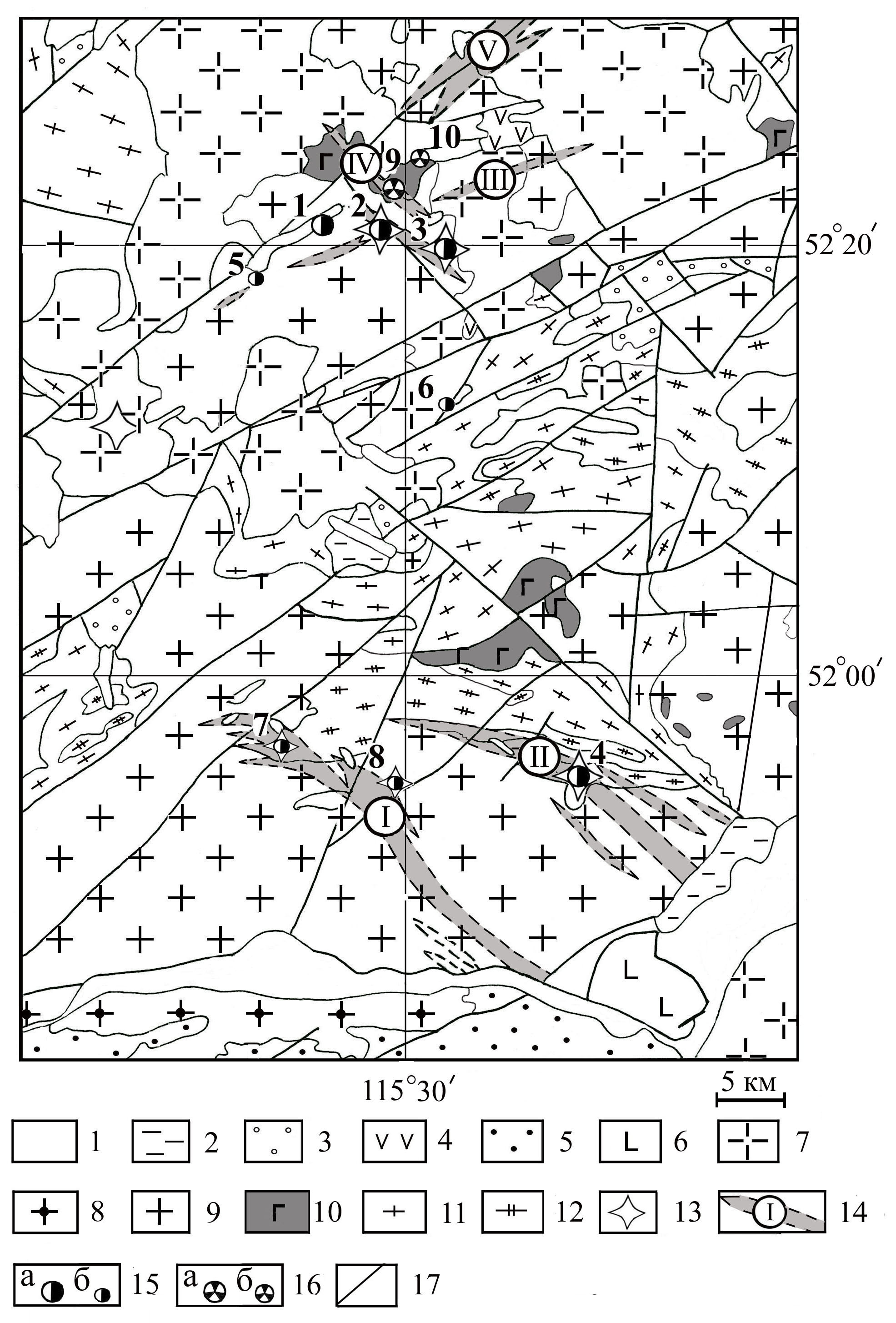|
GOLD-BEARING OF THE DARASUN ORE DISTRICT FLUID-EXPLOSIVE STRUCTURES Institute of Natural Resources Ecology and Cryology SB RAS, Chita, Russia, inrec.sbras@mail.ru
Fluid-explosive bodies composed by breccias that were formed as a result of underground explosives being a consequence of water and gas pressure spasmodic change are understood as fluid-explosive structures (FES) (Tugovik, 1984). In the Darasun ore district, FES fill in cavities of pipe-like oval and rounded forms from several tens to several hundreds meters in size. In East Transbaikalia, FES are developed in ore fields of the Mesozoic most gold deposits. They have been observed in the Darasun, Baleiskiy, Apa-Ilinskiy, Klyuchevskoi and other gold deposits. Locations of most Mesozoic gold deposits and occurrences are paragenetically associated with small intrusions of the same age (Timofeevsky, 1972). FES formation is also associated with the latter ones. In the Darasun ore district, FES, apart from the Darasun deposit, have been revealed in the Teremkinskoe, Del'machik gold deposits and Baitsetuiskoe, Geremnakskoe gold occurrences (Fig.1). FES formation in the Darasun ore district is close in time to that of dyke belts. The thickness of the dyke belts ranges from several hundreds meters to several kilometers, and their length reaches 40 km. Granite-porphyries, quartz porphyries, dacite porphyries, granodiorite-porphyries dominate in rock composition of the dyke belts. Diorite porphyries, lamprophyres, diorite and diabase porphyrites are more rarely noted. By data of the previous researchers, FES formation preceeds, as a rule, the productive stage of gold mineralization in the gold deposits of East Transbaikalia. In the Darasun deposit, FES are developed in central part of ore field. In fact, they are isometrically outlined and spatially associated with intrusions of plagiogranite-porphyries. It was found that formation of tectonic dislocation zones hosted the ore bodies occurred simultaneously with formation of fluid-explosive breccias. It is indicated by the fact that the material cementing the breccias and vein fractures of the ore deposition early stages is the same (quartz-tourmaline, quartz-pyrite association) (Timofeevsky, 1972). Metasomatic transformation of rocks (propilitization, beresitization, listvenitization) and development of stockwork impregnated mineralization are spatially associated with FES. Gold contents are of no economical value in them (Kulikova et al., 1996)
1 – Q deposits (pebbles, sands, clays, sandy loams); 2 – N-Q deposits (sands, clays, sandy loams); 3 – J3 Olovskaya suite (sand stones, aleurolites, conglomerate, trachybasalts, tuffs); 4 – J3 Ukureiskaya suite (sandstones, tuff-sandstones, aleurolites, trachyandesites, tuffs); 5 – T3 Upper Mogotuiskaya subseries (aleurolites, argillites with interlayers of sandstones); 6 – R1 Kulindinskaya suite (metaeffusives of main composition, coaly shales, quartzites); 7 – J2-3 granitoids of the Amudzhikano-Sretenskiy Complex; 8 – T3 granitoids of the Bichura Complex; 9 – Paleozoic granitoids; 10 – PZ1 basites of the Kruchininskiy Complex; 11 – PR1 gneiss-like, banded granitoids; 12 – AR1 metamorphic associations of granulite and amphibolite facies of complex composition; 13 – fluid-explosive structures; 14 – dyke belts: I – Baitsetuiskiy, ii - Dil'machik, III – Borovushkinskiy-Teremkinskiy, IV – Darasun, V – Boroin-Baitsinskiy; 15 (a) gold deposits: Talatuiskoe, 2 – Teremkinskoe, 3 – Darasun, 4 - Dil'machik; (b) gold occurrences: 5 – Borovushkinskoe, 6 – Torgokonskoe, 7 – Baitsetuiskoe, 8 – Goremnakskoe; 16 – silver-lead occurrences: (a) 9 – Usty-Teremkinskoe deposit, (b) Sokolanskoe ore occurrence; 17 – tectonic dislocations. We have studied FES gold-bearing in the Del'machik gold deposit, the presence of funnel-shaped breccia body of 1750 x 1000 m in size being its specific peculiarity. The host rocks are composed by the Pre-Cambrian granitoids. Two types of mineralization are distinguished. The first type is spread outside the pipe-like breccia body and presented by gold-sulfide-quartz veins up to 30 cm thick. The ore bodies are localized in zones of schist formation. The second type is developed within breccia body. Gold mineralization localizes in the metasomatically altered breccias with veinlet-impregnated mineralization and more rarely – in zones of veinlet silicification. The thickness of the ore zones reaches 70 m. The quantity of the ore minerals equals 10-15 %. The main ore minerals are pyrite, arsenopyrite, pyrrhotite and chalcopyrite. The gold average content makes up 3.6 ppm in the ore bodies. The correlational analysis revealed close association of gold with zinc in the metasomatically altered breccias (r = 0.6). Thus, FES are typical for the Mesozoic gold deposits of East Transbaikalia. A close spatial association of explosive breccias with the Mesozoic dyke belts is marked. As a rule, FES formation preceeds the productive stage of gold mineralization. References Kulikova Z.I., Gulina V.A., Zorina L.D. (1996). Indicatory role of explosive breccias in genesis of Teremkinskoe gold deposit // Geology and Geophysics, v.37, N12, P.61-72. Timofeevsky D.A. (1972) Geology and minerageny of the Darasun gold ore region. M., Mir, 260p. Tugovik G.I. (1984) Fluid-explosive structures and their ore-bearing. M., Nauka, 193p.
|
